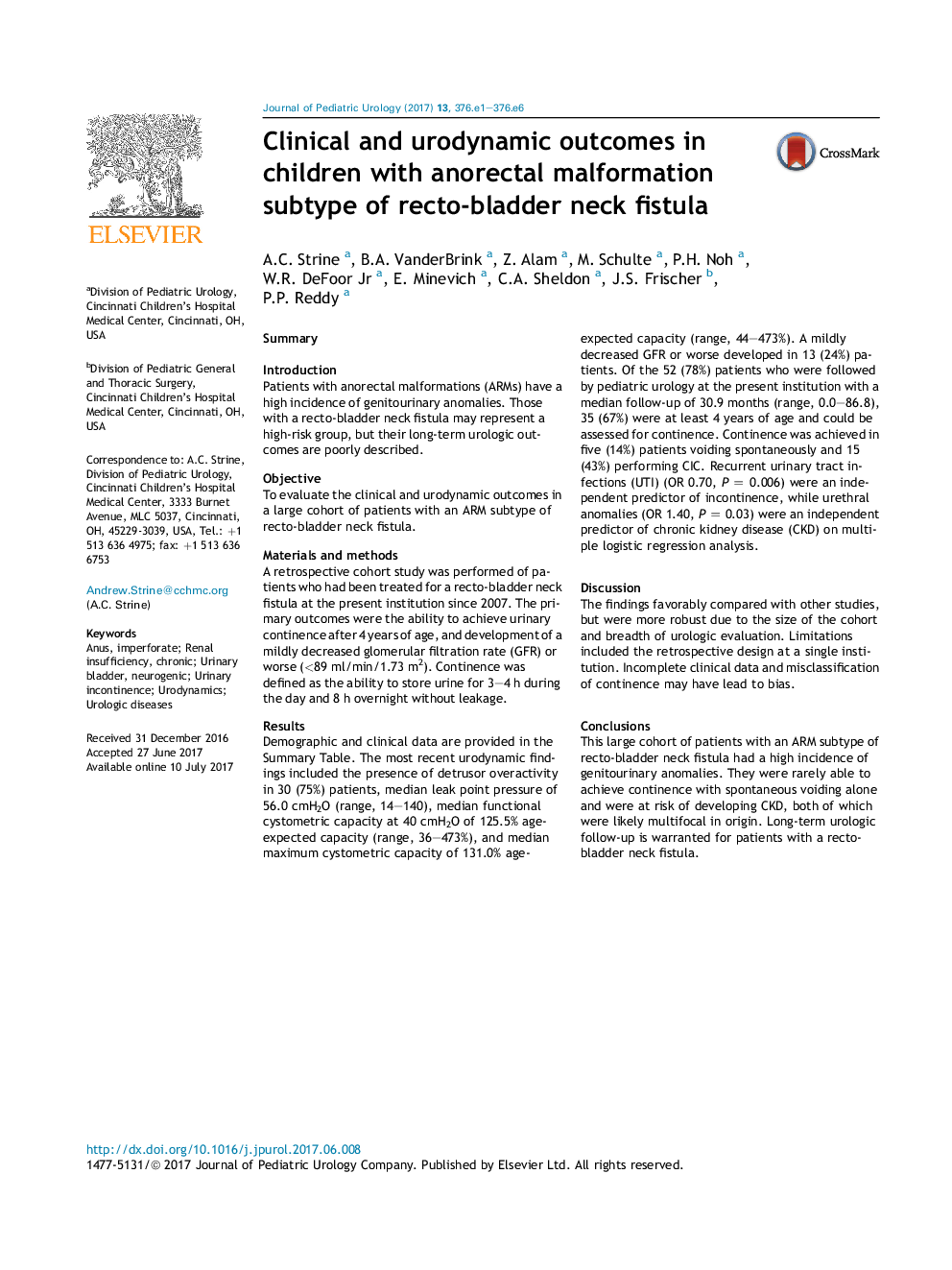| کد مقاله | کد نشریه | سال انتشار | مقاله انگلیسی | نسخه تمام متن |
|---|---|---|---|---|
| 5718548 | 1607135 | 2017 | 6 صفحه PDF | دانلود رایگان |
SummaryIntroductionPatients with anorectal malformations (ARMs) have a high incidence of genitourinary anomalies. Those with a recto-bladder neck fistula may represent a high-risk group, but their long-term urologic outcomes are poorly described.ObjectiveTo evaluate the clinical and urodynamic outcomes in a large cohort of patients with an ARM subtype of recto-bladder neck fistula.Materials and methodsA retrospective cohort study was performed of patients who had been treated for a recto-bladder neck fistula at the present institution since 2007. The primary outcomes were the ability to achieve urinary continence after 4 years of age, and development of a mildly decreased glomerular filtration rate (GFR) or worse (<89 ml/min/1.73 m2). Continence was defined as the ability to store urine for 3-4 h during the day and 8 h overnight without leakage.ResultsDemographic and clinical data are provided in the Summary Table. The most recent urodynamic findings included the presence of detrusor overactivity in 30 (75%) patients, median leak point pressure of 56.0 cmH2O (range, 14-140), median functional cystometric capacity at 40 cmH2O of 125.5% age-expected capacity (range, 36-473%), and median maximum cystometric capacity of 131.0% age-expected capacity (range, 44-473%). A mildly decreased GFR or worse developed in 13 (24%) patients. Of the 52 (78%) patients who were followed by pediatric urology at the present institution with a median follow-up of 30.9 months (range, 0.0-86.8), 35 (67%) were at least 4 years of age and could be assessed for continence. Continence was achieved in five (14%) patients voiding spontaneously and 15 (43%) performing CIC. Recurrent urinary tract infections (UTI) (OR 0.70, P = 0.006) were an independent predictor of incontinence, while urethral anomalies (OR 1.40, P = 0.03) were an independent predictor of chronic kidney disease (CKD) on multiple logistic regression analysis.DiscussionThe findings favorably compared with other studies, but were more robust due to the size of the cohort and breadth of urologic evaluation. Limitations included the retrospective design at a single institution. Incomplete clinical data and misclassification of continence may have lead to bias.ConclusionsThis large cohort of patients with an ARM subtype of recto-bladder neck fistula had a high incidence of genitourinary anomalies. They were rarely able to achieve continence with spontaneous voiding alone and were at risk of developing CKD, both of which were likely multifocal in origin. Long-term urologic follow-up is warranted for patients with a recto-bladder neck fistula.Summary Table. Demographic and clinical data.Urologic follow-up at the present institution (n = 52)No urologic follow-up at the present institution (n = 15)P-valueMedian age at posterior sagittal anorectoplasty in months (range)6.9 (0.0-100.8)7.1 (2.7-78.9)0.98Posterior sagittal anorectoplasty at the present institution, n (%)37 (71)11 (73)1.00Re-operative posterior sagittal anorectoplasty, n (%)26 (50)6 (40)0.57Laparoscopic assistance, n (%)12 (23)3 (20)1.00Tethered cord, n (%)22 (42)4 (27)0.37Tethered cord release, n (%)15 (29)4 (27)1.00Median sacral ratio (range) Anteroposterior0.60 (0.00-1.20)0.57 (0.00-1.06)0.47 Lateral0.61 (0.00-1.20)0.62 (0.00-1.47)0.98Recurrent UTI, n (%)27 (52)5 (33)0.25Epididymo-orchitis, n (%)5 (10)0 (0)0.58Pre-operative hydronephrosis, n (%)26 (55)5 (56)1.00Pre-operative VUR, n (%)27 (57)6 (55)1.00Solitary kidney, n (%)21 (40)4 (27)0.38Upper-tract anomalies (e.g. ureteropelvic junction obstruction, ureterovesical junction obstruction, ectopic ureter, ureterocele, renal fusion anomaly), n (%)14 (27)2 (13)0.49Hypospadias, n (%)19 (37)4 (27)0.55Urethral anomalies (e.g. PUV, urethral atresia, congenital urethral stricture, megalourethra), n (%)14 (27)1 (7)0.16Undescended testis, n (%)18 (35)5 (33)1.00Most recent median GFR in ml/min/1.73 m2 (range)108.0 (0-187)106.5 (62-147)0.96GFR, glomerular filtration rate.
Journal: Journal of Pediatric Urology - Volume 13, Issue 4, August 2017, Pages 376.e1-376.e6
